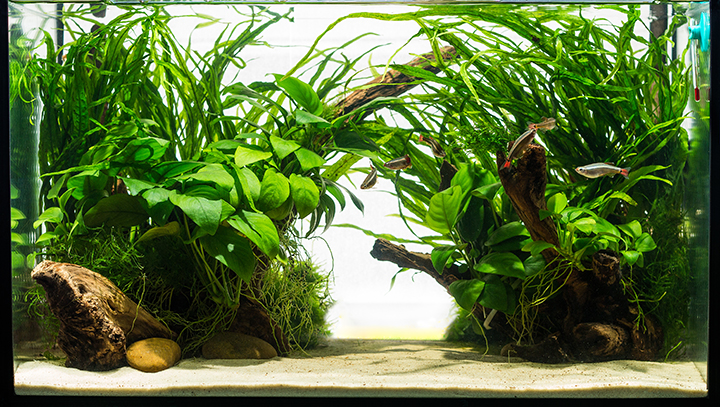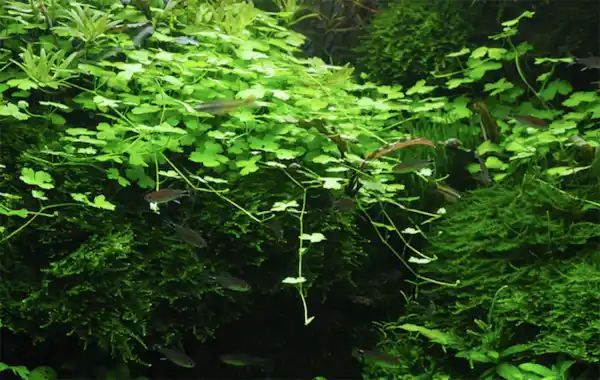For many, an aquarium full of lush plant growth is the pinnacle of freshwater fishkeeping. Emulating professional aquascapes can be very difficult and costly but beginner-friendly planted tanks can be equally as captivating.
Image above: Hydrocotyle tripartita looks great against mosses.
The most important guide of keeping plants is to have a balanced triangle. Aquatic plants require light, nutrients and carbon dioxide for healthy growth. A slow growing plant needs less of each compared to a fast growing plant. If these elements are unbalanced then algae may prevail and plant health will suffer.

The average ‘starter kit’ aquarium is perfectly suitable for keeping slow growing plants with little to no extra expense. For most rooted plants, some form of substrate containing nutrients is of importance. These are offered, most commonly, as compressed soil (hard, gravel-like pellets) or as loose soil that requires ‘capping’ with a layer of fine gravel (0.5-2mm) or sand.
Tablets are available to add nutrients to inert substrates (gravel and sand) but this is generally less effective than offering a high-nutrient substrate and tablets are best used to ‘recharge’ spent nutrient substrates.

Image: Cryptocoryne species and grassy Vallisneria prefer nutrient substrates.
Most species of Cryptocoryne, Staurogyne, Rotala, Ceratopteris, Bacopa, Vallisneria and more will grow far stronger given a nutrient substrate but others don’t need it. Many low-light plants grow over wood or rocks, like ivy on a house. These plants are also very low maintenance and include all Anubias, Microsorum (Java ferns), Bucephalandra, Bolbitis and mosses.

Image: Anubias, Bucephalandra, Java fern and Bolbitis.
Other plants that do well without the need for nutrient substrates include Elodea and Hydrocotyle species, and Ceratophyllum demersum (Hornwort). But these, and all the above mentioned plants, do require nutrients in the water – simply provided by adding a liquid fertiliser regularly.

Image: Hydrocotyle, Hornwort and Elodea.
Liquid fertilizers come in two styles – ‘lite’ or complete. Complete fertilisers include all nutrients a plant needs, including nitrogen (of which some are nitrates) and phosphates. The average aquarium produces enough nitrate and phosphate, through fish waste, to keep all but the fastest growing plant species. So, treating with lite fertilisers (with no nitrate or phosphate) is the way forward for aquaria with good fish stocks.

Image: Anubias nana and Java fern ‘narrow’ require no nutrient substrate.
If plants don’t get enough light they tend to reach for it, becoming leggy and sparce – often producing leaves only near the surface. You may well see advice suggesting types of Myriophyllum, Hygrophila and Limnophila as good beginner plants. They are easy to grow but they are not good plants for lower light levels (most starter kits) so they may be best avoided.
Definitely do avoid houseplants! There are still many shops that sell ‘old school’ houseplant cuttings to put in aquaria. These plants stand no chance of surviving underwater and will rot over the course of four to eight weeks. Some shop assistants may point this out but not all, so get accustomed with what to avoid here: www.practicalfishkeeping.co.uk/features/21-plants-to-avoid-in-the-aquarium
Plants can be added to a new set-up immediately and actually aid cycling slightly. When planting, remove baskets and growing media or plant weights from shop bought plants.








